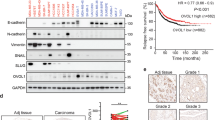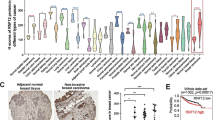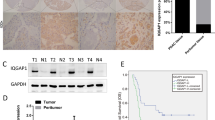Abstract
MEMO1 (mediator of ErbB2-driven cell motility 1) regulates HER2-dependent cell migration. Increased MEMO1 expression is associated with cancer aggressiveness. Here, we found that MEMO1 is also involved in breast carcinogenesis via regulating insulin-like growth factor-I receptor-dependent signaling events. We showed that MEMO1 binds to insulin receptor substrate 1, activates the downstream PI3K/Akt signaling pathway, leads to upregulation of Snail1 and thereby triggers the epithelial-mesenchymal transition (EMT) program. In addition, MEMO1 overexpression is accompanied by growth factor-independent proliferation, anchorage-independent growth in soft agar, and enhanced metastatic potential. Together, these findings suggest that MEMO1 acts as an oncogene and is a potential therapeutic target for cancer treatment.
This is a preview of subscription content, access via your institution
Access options
Subscribe to this journal
Receive 50 print issues and online access
$259.00 per year
only $5.18 per issue
Buy this article
- Purchase on Springer Link
- Instant access to full article PDF
Prices may be subject to local taxes which are calculated during checkout






Similar content being viewed by others
References
Marone R, Hess D, Dankort D, Muller WJ, Hynes NE, Badache A . Memo mediates ErbB2-driven cell motility. Nat Cell Biol 2004; 6: 515–522.
Zaoui K, Honore S, Isnardon D, Braguer D, Badache A . Memo-RhoA-mDia1 signaling controls microtubules, the actin network, and adhesion site formation in migrating cells. J Cell Biol 2008; 183: 401–408.
Zaoui K, Benseddik K, Daou P, Salaun D, Badache A . ErbB2 receptor controls microtubule capture by recruiting ACF7 to the plasma membrane of migrating cells. Proc Natl Acad Sci USA 2010; 107: 18517–18522.
Qiu C, Lienhard S, Hynes NE, Badache A, Leahy DJ . Memo is homologous to nonheme iron dioxygenases and binds an ErbB2-derived phosphopeptide in its vestigial active site. J Biol Chem 2008; 283: 2734–2740.
White MF . Regulating insulin signaling and beta-cell function through IRS proteins. Can J Physiol Pharmacol 2006; 84: 725–737.
Sun XJ, Rothenberg P, Kahn CR, Backer JM, Araki E, Wilden PA et al. Structure of the insulin receptor substrate IRS-1 defines a unique signal transduction protein. Nature 1991; 352: 73–77.
Mardilovich K, Pankratz SL, Shaw LM . Expression and function of the insulin receptor substrate proteins in cancer. Cell Commun Signal 2009; 7: 14.
Gibson SL, Ma Z, Shaw LM . Divergent roles for IRS-1 and IRS-2 in breast cancer metastasis. Cell Cycle 2007; 6: 631–637.
Bergmann U, Funatomi H, Kornmann M, Beger HG, Korc M . Increased expression of insulin receptor substrate-1 in human pancreatic cancer. Biochem Biophys Res Commun 1996; 220: 886–890.
Kornmann M, Maruyama H, Bergmann U, Tangvoranuntakul P, Beger HG, White MF et al. Enhanced expression of the insulin receptor substrate-2 docking protein in human pancreatic cancer. Cancer Res 1998; 58: 4250–4254.
Hellawell GO, Turner GD, Davies DR, Poulsom R, Brewster SF, Macaulay VM . Expression of the type 1 insulin-like growth factor receptor is up-regulated in primary prostate cancer and commonly persists in metastatic disease. Cancer Res 2002; 62: 2942–2950.
Hoang CD, Zhang X, Scott PD, Guillaume TJ, Maddaus MA, Yee D et al. Selective activation of insulin receptor substrate-1 and -2 in pleural mesothelioma cells: association with distinct malignant phenotypes. Cancer Res 2004; 64: 7479–7485.
Boissan M, Beurel E, Wendum D, Rey C, Lecluse Y, Housset C et al. Overexpression of insulin receptor substrate-2 in human and murine hepatocellular carcinoma. Am J Pathol 2005; 167: 869–877.
Cantarini MC, de la Monte SM, Pang M, Tong M, D'Errico A, Trevisani F et al. Aspartyl-asparagyl beta hydroxylase over-expression in human hepatoma is linked to activation of insulin-like growth factor and notch signaling mechanisms. Hepatology 2006; 44: 446–457.
Szabolcs M, Keniry M, Simpson L, Reid LJ, Koujak S, Schiff SC et al. Irs2 inactivation suppresses tumor progression in Pten+/− mice. Am J Pathol 2009; 174: 276–286.
Rocha RL, Hilsenbeck SG, Jackson JG, VanDenBerg CL, Weng C, Lee AV et al. Insulin-like growth factor binding protein-3 and insulin receptor substrate-1 in breast cancer: correlation with clinical parameters and disease-free survival. Clin Cancer Res 1997; 3: 103–109.
Del Valle L, Enam S, Lassak A, Wang JY, Croul S, Khalili K et al. Insulin-like growth factor I receptor activity in human medulloblastomas. Clin Cancer Res 2002; 8: 1822–1830.
Ravikumar S, Perez-Liz G, Del Vale L, Soprano DR, Soprano KJ . Insulin receptor substrate-1 is an important mediator of ovarian cancer cell growth suppression by all-trans retinoic acid. Cancer Res 2007; 67: 9266–9275.
Debnath J, Muthuswamy SK, Brugge JS . Morphogenesis and oncogenesis of MCF-10A mammary epithelial acini grown in three-dimensional basement membrane cultures. Methods 2003; 30: 256–268.
Dearth RK, Cui X, Kim HJ, Kuiatse I, Lawrence NA, Zhang X et al. Mammary tumorigenesis and metastasis caused by overexpression of insulin receptor substrate 1 (IRS-1) or IRS-2. Mol Cell Biol 2006; 26: 9302–9314.
Kim HJ, Litzenburger BC, Cui X, Delgado DA, Grabiner BC, Lin X et al. Constitutively active type I insulin-like growth factor receptor causes transformation and xenograft growth of immortalized mammary epithelial cells and is accompanied by an epithelial-to-mesenchymal transition mediated by NF-kappaB and snail. Mol Cell Biol 2007; 27: 3165–3175.
Kalinina T, Gungor C, Thieltges S, Moller-Krull M, Penas EM, Wicklein D et al. Establishment and characterization of a new human pancreatic adenocarcinoma cell line with high metastatic potential to the lung. BMC Cancer 2010; 10: 295.
Hannafon BN, Sebastiani P, de Las Morenas A, Lu J, Rosenberg CL . Expression of microRNA and their gene targets are dysregulated in preinvasive breast cancer. Breast Cancer Res 2011; 13: R24.
Pelicci G, Dente L, De Giuseppe A, Verducci-Galletti B, Giuli S, Mele S et al. A family of Shc related proteins with conserved PTB, CH1 and SH2 regions. Oncogene 1996; 13: 633–641.
Sakai R, Henderson JT, O'Bryan JP, Elia AJ, Saxton TM, Pawson T . The mammalian ShcB and ShcC phosphotyrosine docking proteins function in the maturation of sensory and sympathetic neurons. Neuron 2000; 28: 819–833.
Fagiani E, Giardina G, Luzi L, Cesaroni M, Quarto M, Capra M et al. RaLP, a new member of the Src homology and collagen family, regulates cell migration and tumor growth of metastatic melanomas. Cancer Res 2007; 67: 3064–3073.
Hemi R, Paz K, Wertheim N, Karasik A, Zick Y, Kanety H . Transactivation of ErbB2 and ErbB3 by tumor necrosis factor-alpha and anisomycin leads to impaired insulin signaling through serine/threonine phosphorylation of IRS proteins. J Biol Chem 2002; 277: 8961–8969.
Yenush L, Makati KJ, Smith-Hall J, Ishibashi O, Myers MG, White MF . The pleckstrin homology domain is the principal link between the insulin receptor and IRS-1. J Biol Chem 1996; 271: 24300–24306.
Backer JM, Wjasow C, Zhang Y . In vitro binding and phosphorylation of insulin receptor substrate 1 by the insulin receptor. Role of interactions mediated by the phosphotyrosine-binding domain and the pleckstrin-homology domain. Eur J Biochem 1997; 245: 91–96.
White MF . The insulin signalling system and the IRS proteins. Diabetologia 1997; 40 (Suppl 2): S2–17.
Hanke S, Mann M . The phosphotyrosine interactome of the insulin receptor family and its substrates IRS-1 and IRS-2. Mol Cell Proteomics 2009; 8: 519–534.
Myers MG, Mendez R, Shi P, Pierce JH, Rhoads R, White MF . The COOH-terminal tyrosine phosphorylation sites on IRS-1 bind SHP-2 and negatively regulate insulin signaling. J Biol Chem 1998; 273: 26908–26914.
Sun XJ, Crimmins DL, Myers MG, Miralpeix M, White MF . Pleiotropic insulin signals are engaged by multisite phosphorylation of IRS-1. Mol Cell Biol 1993; 13: 7418–7428.
Debnath J, Brugge JS . Modelling glandular epithelial cancers in three-dimensional cultures. Nat Rev Cancer 2005; 5: 675–688.
Overholtzer M, Zhang J, Smolen GA, Muir B, Li W, Sgroi DC et al. Transforming properties of YAP, a candidate oncogene on the chromosome 11q22 amplicon. Proc Natl Acad Sci USA 2006; 103: 12405–12410.
Kalluri R, Zeisberg M . Fibroblasts in cancer. Nat Rev Cancer 2006; 6: 392–401.
Kalluri R, Weinberg RA . The basics of epithelial-mesenchymal transition. J Clin Invest 2009; 119: 1420–1428.
Sabbah M, Emami S, Redeuilh G, Julien S, Prevost G, Zimber A et al. Molecular signature and therapeutic perspective of the epithelial-to-mesenchymal transitions in epithelial cancers. Drug Resist Updat 2008; 11: 123–151.
Werner H, Le Roith D . New concepts in regulation and function of the insulin-like growth factors: implications for understanding normal growth and neoplasia. Cell Mol Life Sci 2000; 57: 932–942.
Butler AA, Yakar S, Gewolb IH, Karas M, Okubo Y, LeRoith D . Insulin-like growth factor-I receptor signal transduction: at the interface between physiology and cell biology. Comp Biochem Physiol B Biochem Mol Biol 1998; 121: 19–26.
Cantley LC . The phosphoinositide 3-kinase pathway. Science 2002; 296: 1655–1657.
LeRoith D, Roberts CT . The insulin-like growth factor system and cancer. Cancer Lett 2003; 195: 127–137.
Cross DA, Alessi DR, Cohen P, Andjelkovich M, Hemmings BA . Inhibition of glycogen synthase kinase-3 by insulin mediated by protein kinase B. Nature 1995; 378: 785–789.
Zhou BP, Deng J, Xia W, Xu J, Li YM, Gunduz M et al. Dual regulation of Snail by GSK-3beta-mediated phosphorylation in control of epithelial-mesenchymal transition. Nat Cell Biol 2004; 6: 931–940.
Yook JI, Li XY, Ota I, Fearon ER, Weiss SJ . Wnt-dependent regulation of the E-cadherin repressor snail. J Biol Chem 2005; 280: 11740–11748.
Bachelder RE, Yoon SO, Franci C, de Herreros AG, Mercurio AM . Glycogen synthase kinase-3 is an endogenous inhibitor of Snail transcription: implications for the epithelial-mesenchymal transition. J Cell Biol 2005; 168: 29–33.
Wu Y, Deng J, Rychahou PG, Qiu S, Evers BM, Zhou BP . Stabilization of snail by NF-kappaB is required for inflammation-induced cell migration and invasion. Cancer Cell 2009; 15: 416–428.
Julien S, Puig I, Caretti E, Bonaventure J, Nelles L, van Roy F et al. Activation of NF-kappaB by Akt upregulates Snail expression and induces epithelium mesenchyme transition. Oncogene 2007; 26: 7445–7456.
Chua HL, Bhat-Nakshatri P, Clare SE, Morimiya A, Badve S, Nakshatri H . NF-kappaB represses E-cadherin expression and enhances epithelial to mesenchymal transition of mammary epithelial cells: potential involvement of ZEB-1 and ZEB-2. Oncogene 2007; 26: 711–724.
Guaita S, Puig I, Franci C, Garrido M, Dominguez D, Batlle E et al. Snail induction of epithelial to mesenchymal transition in tumor cells is accompanied by MUC1 repression and ZEB1 expression. J Biol Chem 2002; 277: 39209–39216.
Comijn J, Berx G, Vermassen P, Verschueren K, van Grunsven L, Bruyneel E et al. The two-handed E box binding zinc finger protein SIP1 downregulates E-cadherin and induces invasion. Mol Cell 2001; 7: 1267–1278.
Grooteclaes ML, Frisch SM . Evidence for a function of CtBP in epithelial gene regulation and anoikis. Oncogene 2000; 19: 3823–3828.
Batlle E, Sancho E, Franci C, Dominguez D, Monfar M, Baulida J et al. The transcription factor snail is a repressor of E-cadherin gene expression in epithelial tumour cells. Nat Cell Biol 2000; 2: 84–89.
Maehama T, Dixon JE . The tumor suppressor, PTEN/MMAC1, dephosphorylates the lipid second messenger, phosphatidylinositol 3,4,5-trisphosphate. J Biol Chem 1998; 273: 13375–13378.
Meira M, Masson R, Stagljar I, Lienhard S, Maurer F, Boulay A et al. Memo is a cofilin-interacting protein that influences PLCgamma1 and cofilin activities, and is essential for maintaining directionality during ErbB2-induced tumor-cell migration. J Cell Sci 2009; 122: 787–797.
Evdokimova V, Tognon C, Ng T, Ruzanov P, Melnyk N, Fink D et al. Translational activation of snail1 and other developmentally regulated transcription factors by YB-1 promotes an epithelial-mesenchymal transition. Cancer Cell 2009; 15: 402–415.
Sorokin AV, Selyutina AA, Skabkin MA, Guryanov SG, Nazimov IV, Richard C et al. Proteasome-mediated cleavage of the Y-box-binding protein 1 is linked to DNA-damage stress response. EMBO J 2005; 24: 3602–3612.
Acknowledgements
We thank all our colleagues in the Chen laboratory for insightful discussions and technical assistance. We thank Dr Douglas Yee at the University of Minnesota for sharing hIRS2 cDNA and Dr Cosima Baldari at the University of Siena (Italy) for sharing ShcA(p66) cDNA. This work was supported in part by an Era of Hope Research award to JC (W81XWH-09-1-0409). JC is also a recipient of an Era of Hope Scholar award from the Department of Defense (W81XWH-05-1-0470). This work was supported by MD Anderson’s Cancer Center Support Grant (CA016672).
Author information
Authors and Affiliations
Corresponding author
Ethics declarations
Competing interests
The authors declare no conflict of interest.
Additional information
Supplementary Information accompanies the paper on the Oncogene website
Rights and permissions
About this article
Cite this article
Sorokin, A., Chen, J. MEMO1, a new IRS1-interacting protein, induces epithelial–mesenchymal transition in mammary epithelial cells. Oncogene 32, 3130–3138 (2013). https://doi.org/10.1038/onc.2012.327
Received:
Revised:
Accepted:
Published:
Issue Date:
DOI: https://doi.org/10.1038/onc.2012.327
Keywords
This article is cited by
-
Renal FGF23 signaling depends on redox protein Memo1 and promotes orthovanadate-sensitive protein phosphotyrosyl phosphatase activity
Journal of Cell Communication and Signaling (2023)
-
AKT-driven epithelial-mesenchymal transition is affected by copper bioavailability in HER2 negative breast cancer cells via a LOXL2-independent mechanism
Cellular Oncology (2023)
-
Copper in Cancer: from transition metal to potential target
Human Cell (2023)
-
Knockdown of circRNA-Memo1 Reduces Hypoxia/Reoxygenation Injury in Human Brain Endothelial Cells Through miRNA-17-5p/SOS1 Axis
Molecular Neurobiology (2022)
-
Influence of pre-operative oral carbohydrate loading vs. standard fasting on tumor proliferation and clinical outcome in breast cancer patients ─ a randomized trial
BMC Cancer (2019)



